HRM Consultancy Report: Organizational Change at Akbar and Sons
VerifiedAdded on 2023/04/20
|11
|2524
|381
Report
AI Summary
This report addresses the organizational change management challenges faced by Akbar and Sons, an oil company based in the UAE, following its acquisition by BP, a global oil company. The report identifies key issues, including employee reluctance to change, power dynamics, and potential cultural shock due to the integration of BP's diverse workforce. Proposed solutions involve strategic HRM, including formal and informal communication to address change resistance, careful management of the organizational hierarchy, and the implementation of training and development programs to mitigate cultural differences. The report emphasizes the importance of strategic HRM, organizational change management, cultural diversity, and performance management, concluding that a well-designed change management strategy is crucial for achieving organizational goals and ensuring long-term sustainability. The report also highlights the need for a balanced approach to HRM and change management to foster employee motivation and organizational success.
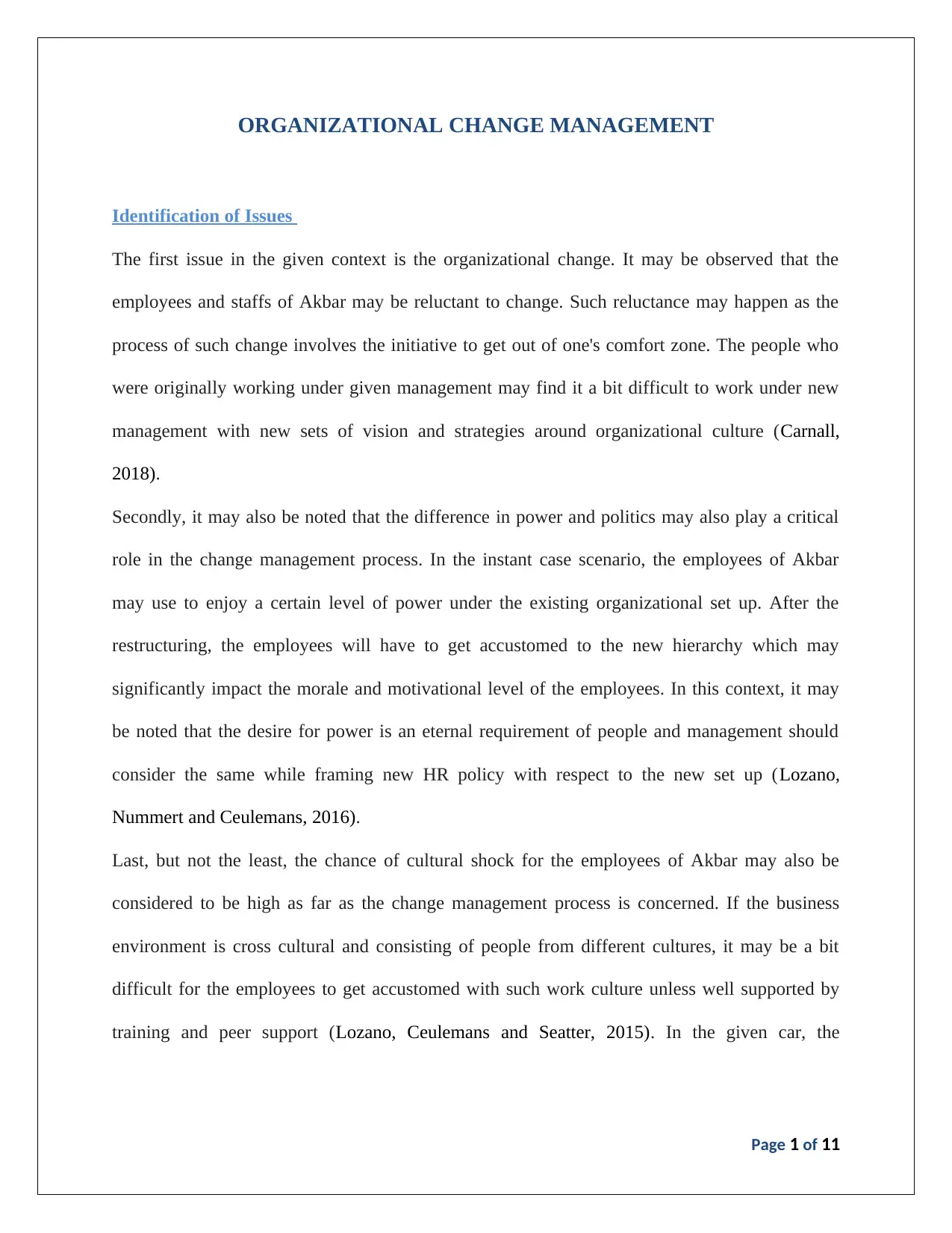
ORGANIZATIONAL CHANGE MANAGEMENT
Identification of Issues
The first issue in the given context is the organizational change. It may be observed that the
employees and staffs of Akbar may be reluctant to change. Such reluctance may happen as the
process of such change involves the initiative to get out of one's comfort zone. The people who
were originally working under given management may find it a bit difficult to work under new
management with new sets of vision and strategies around organizational culture (Carnall,
2018).
Secondly, it may also be noted that the difference in power and politics may also play a critical
role in the change management process. In the instant case scenario, the employees of Akbar
may use to enjoy a certain level of power under the existing organizational set up. After the
restructuring, the employees will have to get accustomed to the new hierarchy which may
significantly impact the morale and motivational level of the employees. In this context, it may
be noted that the desire for power is an eternal requirement of people and management should
consider the same while framing new HR policy with respect to the new set up (Lozano,
Nummert and Ceulemans, 2016).
Last, but not the least, the chance of cultural shock for the employees of Akbar may also be
considered to be high as far as the change management process is concerned. If the business
environment is cross cultural and consisting of people from different cultures, it may be a bit
difficult for the employees to get accustomed with such work culture unless well supported by
training and peer support (Lozano, Ceulemans and Seatter, 2015). In the given car, the
Page 1 of 11
Identification of Issues
The first issue in the given context is the organizational change. It may be observed that the
employees and staffs of Akbar may be reluctant to change. Such reluctance may happen as the
process of such change involves the initiative to get out of one's comfort zone. The people who
were originally working under given management may find it a bit difficult to work under new
management with new sets of vision and strategies around organizational culture (Carnall,
2018).
Secondly, it may also be noted that the difference in power and politics may also play a critical
role in the change management process. In the instant case scenario, the employees of Akbar
may use to enjoy a certain level of power under the existing organizational set up. After the
restructuring, the employees will have to get accustomed to the new hierarchy which may
significantly impact the morale and motivational level of the employees. In this context, it may
be noted that the desire for power is an eternal requirement of people and management should
consider the same while framing new HR policy with respect to the new set up (Lozano,
Nummert and Ceulemans, 2016).
Last, but not the least, the chance of cultural shock for the employees of Akbar may also be
considered to be high as far as the change management process is concerned. If the business
environment is cross cultural and consisting of people from different cultures, it may be a bit
difficult for the employees to get accustomed with such work culture unless well supported by
training and peer support (Lozano, Ceulemans and Seatter, 2015). In the given car, the
Page 1 of 11
Paraphrase This Document
Need a fresh take? Get an instant paraphrase of this document with our AI Paraphraser
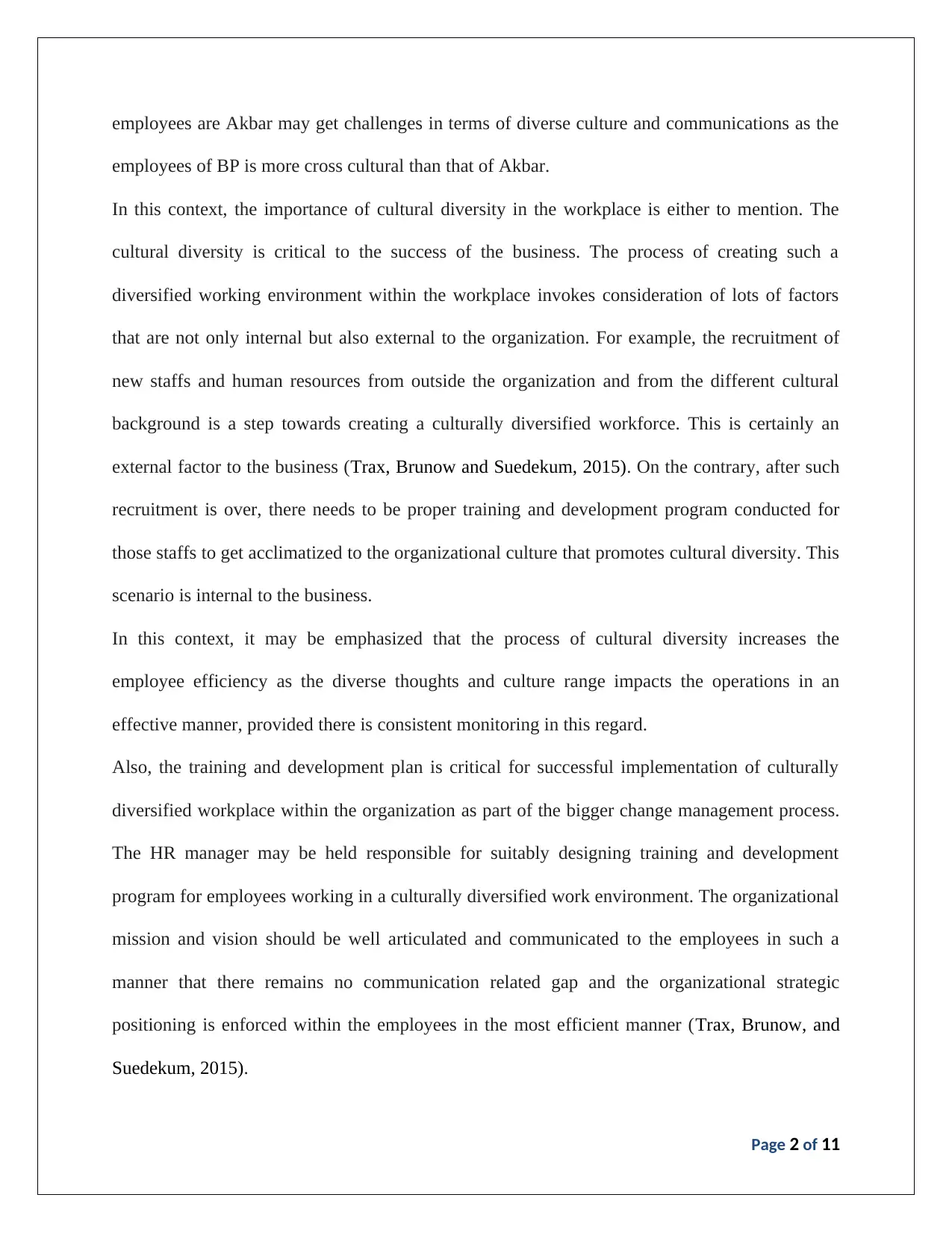
employees are Akbar may get challenges in terms of diverse culture and communications as the
employees of BP is more cross cultural than that of Akbar.
In this context, the importance of cultural diversity in the workplace is either to mention. The
cultural diversity is critical to the success of the business. The process of creating such a
diversified working environment within the workplace invokes consideration of lots of factors
that are not only internal but also external to the organization. For example, the recruitment of
new staffs and human resources from outside the organization and from the different cultural
background is a step towards creating a culturally diversified workforce. This is certainly an
external factor to the business (Trax, Brunow and Suedekum, 2015). On the contrary, after such
recruitment is over, there needs to be proper training and development program conducted for
those staffs to get acclimatized to the organizational culture that promotes cultural diversity. This
scenario is internal to the business.
In this context, it may be emphasized that the process of cultural diversity increases the
employee efficiency as the diverse thoughts and culture range impacts the operations in an
effective manner, provided there is consistent monitoring in this regard.
Also, the training and development plan is critical for successful implementation of culturally
diversified workplace within the organization as part of the bigger change management process.
The HR manager may be held responsible for suitably designing training and development
program for employees working in a culturally diversified work environment. The organizational
mission and vision should be well articulated and communicated to the employees in such a
manner that there remains no communication related gap and the organizational strategic
positioning is enforced within the employees in the most efficient manner (Trax, Brunow, and
Suedekum, 2015).
Page 2 of 11
employees of BP is more cross cultural than that of Akbar.
In this context, the importance of cultural diversity in the workplace is either to mention. The
cultural diversity is critical to the success of the business. The process of creating such a
diversified working environment within the workplace invokes consideration of lots of factors
that are not only internal but also external to the organization. For example, the recruitment of
new staffs and human resources from outside the organization and from the different cultural
background is a step towards creating a culturally diversified workforce. This is certainly an
external factor to the business (Trax, Brunow and Suedekum, 2015). On the contrary, after such
recruitment is over, there needs to be proper training and development program conducted for
those staffs to get acclimatized to the organizational culture that promotes cultural diversity. This
scenario is internal to the business.
In this context, it may be emphasized that the process of cultural diversity increases the
employee efficiency as the diverse thoughts and culture range impacts the operations in an
effective manner, provided there is consistent monitoring in this regard.
Also, the training and development plan is critical for successful implementation of culturally
diversified workplace within the organization as part of the bigger change management process.
The HR manager may be held responsible for suitably designing training and development
program for employees working in a culturally diversified work environment. The organizational
mission and vision should be well articulated and communicated to the employees in such a
manner that there remains no communication related gap and the organizational strategic
positioning is enforced within the employees in the most efficient manner (Trax, Brunow, and
Suedekum, 2015).
Page 2 of 11
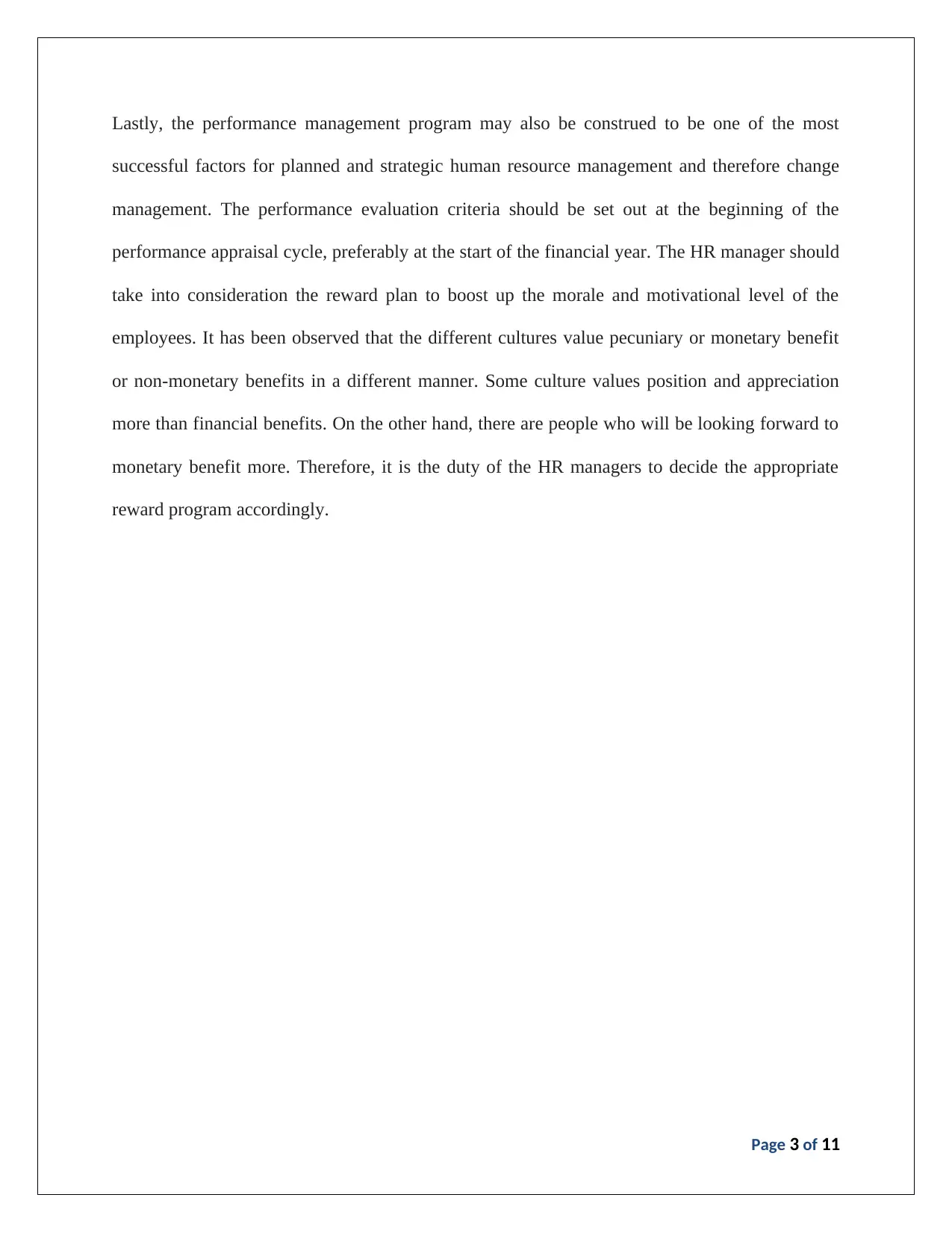
Lastly, the performance management program may also be construed to be one of the most
successful factors for planned and strategic human resource management and therefore change
management. The performance evaluation criteria should be set out at the beginning of the
performance appraisal cycle, preferably at the start of the financial year. The HR manager should
take into consideration the reward plan to boost up the morale and motivational level of the
employees. It has been observed that the different cultures value pecuniary or monetary benefit
or non-monetary benefits in a different manner. Some culture values position and appreciation
more than financial benefits. On the other hand, there are people who will be looking forward to
monetary benefit more. Therefore, it is the duty of the HR managers to decide the appropriate
reward program accordingly.
Page 3 of 11
successful factors for planned and strategic human resource management and therefore change
management. The performance evaluation criteria should be set out at the beginning of the
performance appraisal cycle, preferably at the start of the financial year. The HR manager should
take into consideration the reward plan to boost up the morale and motivational level of the
employees. It has been observed that the different cultures value pecuniary or monetary benefit
or non-monetary benefits in a different manner. Some culture values position and appreciation
more than financial benefits. On the other hand, there are people who will be looking forward to
monetary benefit more. Therefore, it is the duty of the HR managers to decide the appropriate
reward program accordingly.
Page 3 of 11
⊘ This is a preview!⊘
Do you want full access?
Subscribe today to unlock all pages.

Trusted by 1+ million students worldwide
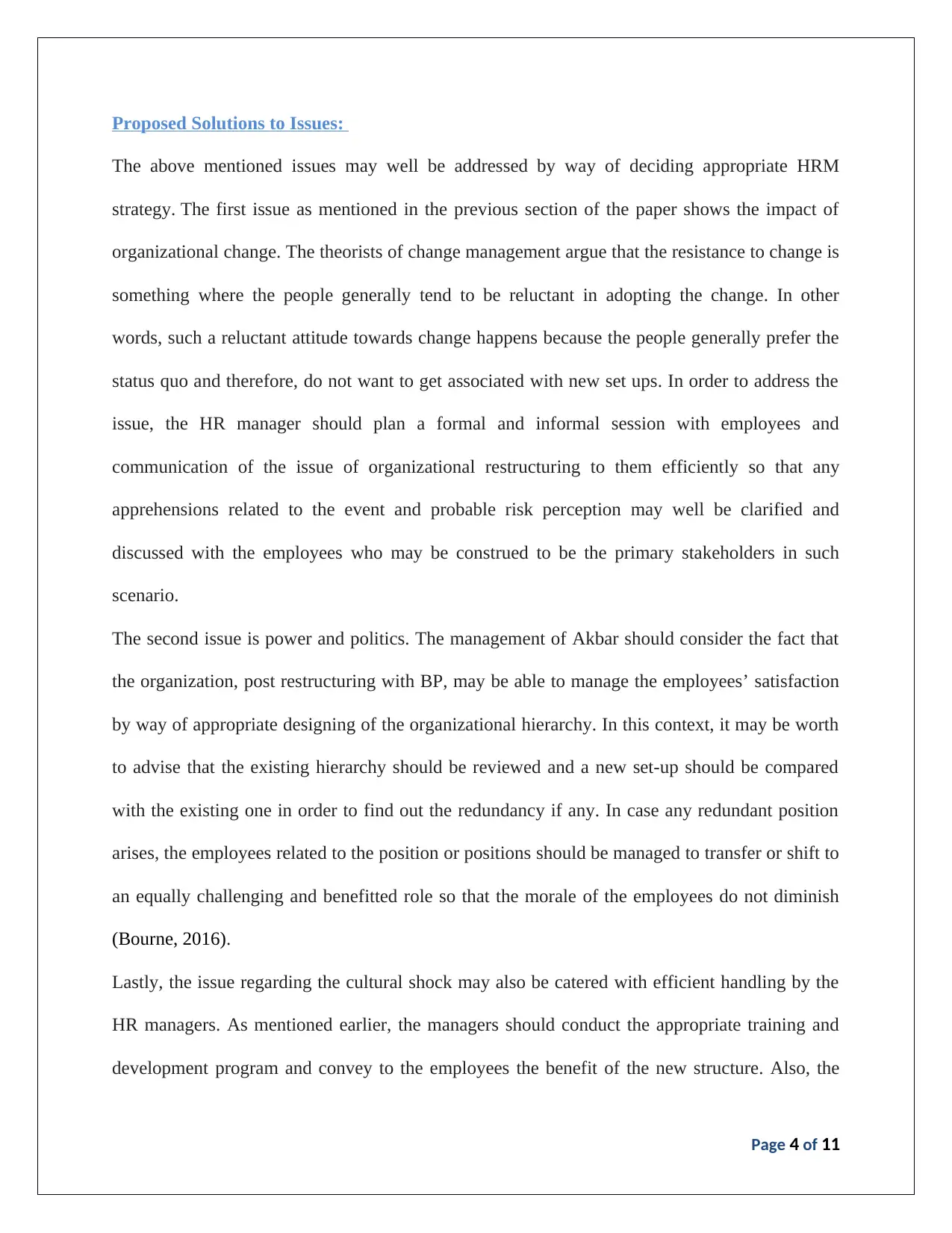
Proposed Solutions to Issues:
The above mentioned issues may well be addressed by way of deciding appropriate HRM
strategy. The first issue as mentioned in the previous section of the paper shows the impact of
organizational change. The theorists of change management argue that the resistance to change is
something where the people generally tend to be reluctant in adopting the change. In other
words, such a reluctant attitude towards change happens because the people generally prefer the
status quo and therefore, do not want to get associated with new set ups. In order to address the
issue, the HR manager should plan a formal and informal session with employees and
communication of the issue of organizational restructuring to them efficiently so that any
apprehensions related to the event and probable risk perception may well be clarified and
discussed with the employees who may be construed to be the primary stakeholders in such
scenario.
The second issue is power and politics. The management of Akbar should consider the fact that
the organization, post restructuring with BP, may be able to manage the employees’ satisfaction
by way of appropriate designing of the organizational hierarchy. In this context, it may be worth
to advise that the existing hierarchy should be reviewed and a new set-up should be compared
with the existing one in order to find out the redundancy if any. In case any redundant position
arises, the employees related to the position or positions should be managed to transfer or shift to
an equally challenging and benefitted role so that the morale of the employees do not diminish
(Bourne, 2016).
Lastly, the issue regarding the cultural shock may also be catered with efficient handling by the
HR managers. As mentioned earlier, the managers should conduct the appropriate training and
development program and convey to the employees the benefit of the new structure. Also, the
Page 4 of 11
The above mentioned issues may well be addressed by way of deciding appropriate HRM
strategy. The first issue as mentioned in the previous section of the paper shows the impact of
organizational change. The theorists of change management argue that the resistance to change is
something where the people generally tend to be reluctant in adopting the change. In other
words, such a reluctant attitude towards change happens because the people generally prefer the
status quo and therefore, do not want to get associated with new set ups. In order to address the
issue, the HR manager should plan a formal and informal session with employees and
communication of the issue of organizational restructuring to them efficiently so that any
apprehensions related to the event and probable risk perception may well be clarified and
discussed with the employees who may be construed to be the primary stakeholders in such
scenario.
The second issue is power and politics. The management of Akbar should consider the fact that
the organization, post restructuring with BP, may be able to manage the employees’ satisfaction
by way of appropriate designing of the organizational hierarchy. In this context, it may be worth
to advise that the existing hierarchy should be reviewed and a new set-up should be compared
with the existing one in order to find out the redundancy if any. In case any redundant position
arises, the employees related to the position or positions should be managed to transfer or shift to
an equally challenging and benefitted role so that the morale of the employees do not diminish
(Bourne, 2016).
Lastly, the issue regarding the cultural shock may also be catered with efficient handling by the
HR managers. As mentioned earlier, the managers should conduct the appropriate training and
development program and convey to the employees the benefit of the new structure. Also, the
Page 4 of 11
Paraphrase This Document
Need a fresh take? Get an instant paraphrase of this document with our AI Paraphraser
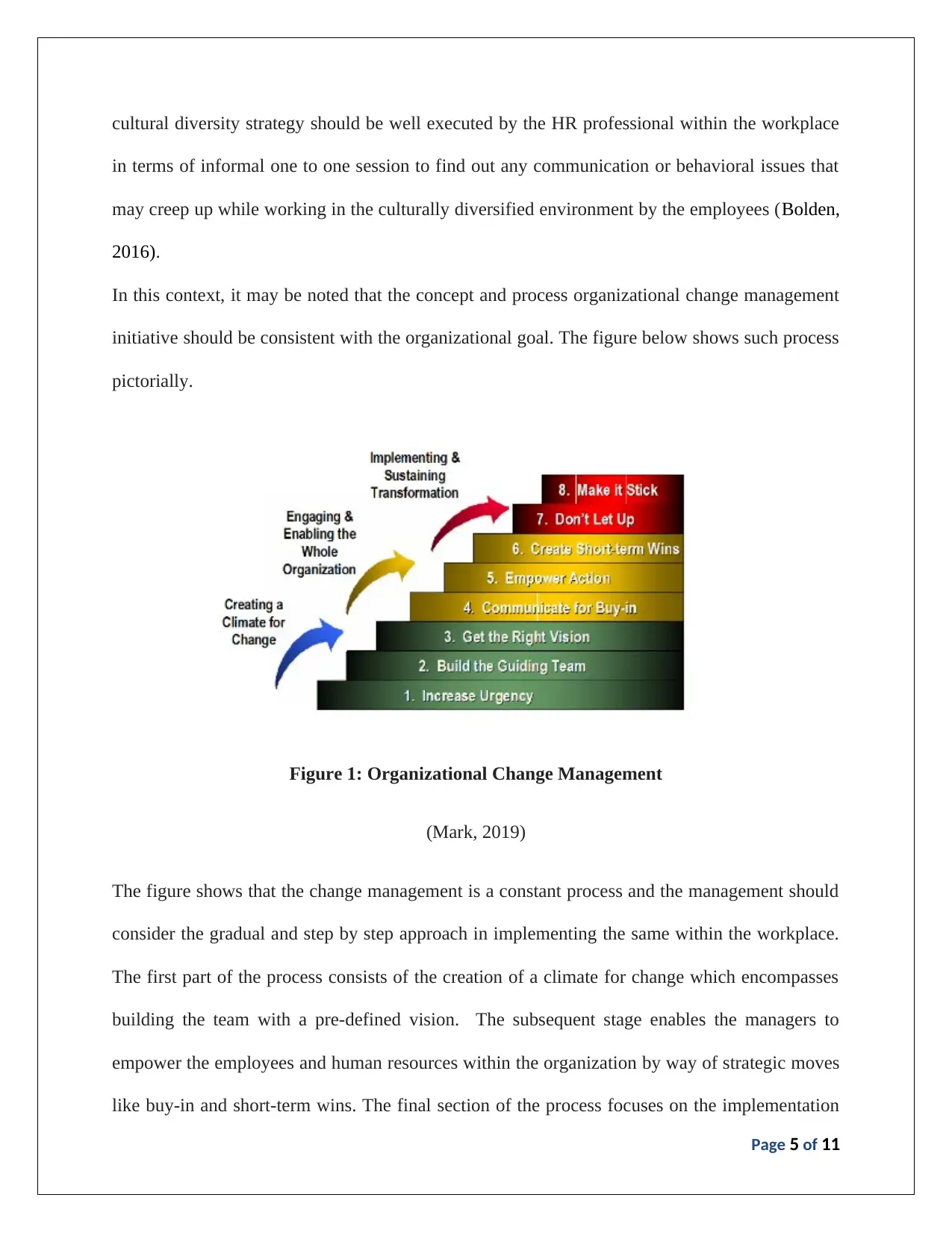
cultural diversity strategy should be well executed by the HR professional within the workplace
in terms of informal one to one session to find out any communication or behavioral issues that
may creep up while working in the culturally diversified environment by the employees (Bolden,
2016).
In this context, it may be noted that the concept and process organizational change management
initiative should be consistent with the organizational goal. The figure below shows such process
pictorially.
Figure 1: Organizational Change Management
(Mark, 2019)
The figure shows that the change management is a constant process and the management should
consider the gradual and step by step approach in implementing the same within the workplace.
The first part of the process consists of the creation of a climate for change which encompasses
building the team with a pre-defined vision. The subsequent stage enables the managers to
empower the employees and human resources within the organization by way of strategic moves
like buy-in and short-term wins. The final section of the process focuses on the implementation
Page 5 of 11
in terms of informal one to one session to find out any communication or behavioral issues that
may creep up while working in the culturally diversified environment by the employees (Bolden,
2016).
In this context, it may be noted that the concept and process organizational change management
initiative should be consistent with the organizational goal. The figure below shows such process
pictorially.
Figure 1: Organizational Change Management
(Mark, 2019)
The figure shows that the change management is a constant process and the management should
consider the gradual and step by step approach in implementing the same within the workplace.
The first part of the process consists of the creation of a climate for change which encompasses
building the team with a pre-defined vision. The subsequent stage enables the managers to
empower the employees and human resources within the organization by way of strategic moves
like buy-in and short-term wins. The final section of the process focuses on the implementation
Page 5 of 11
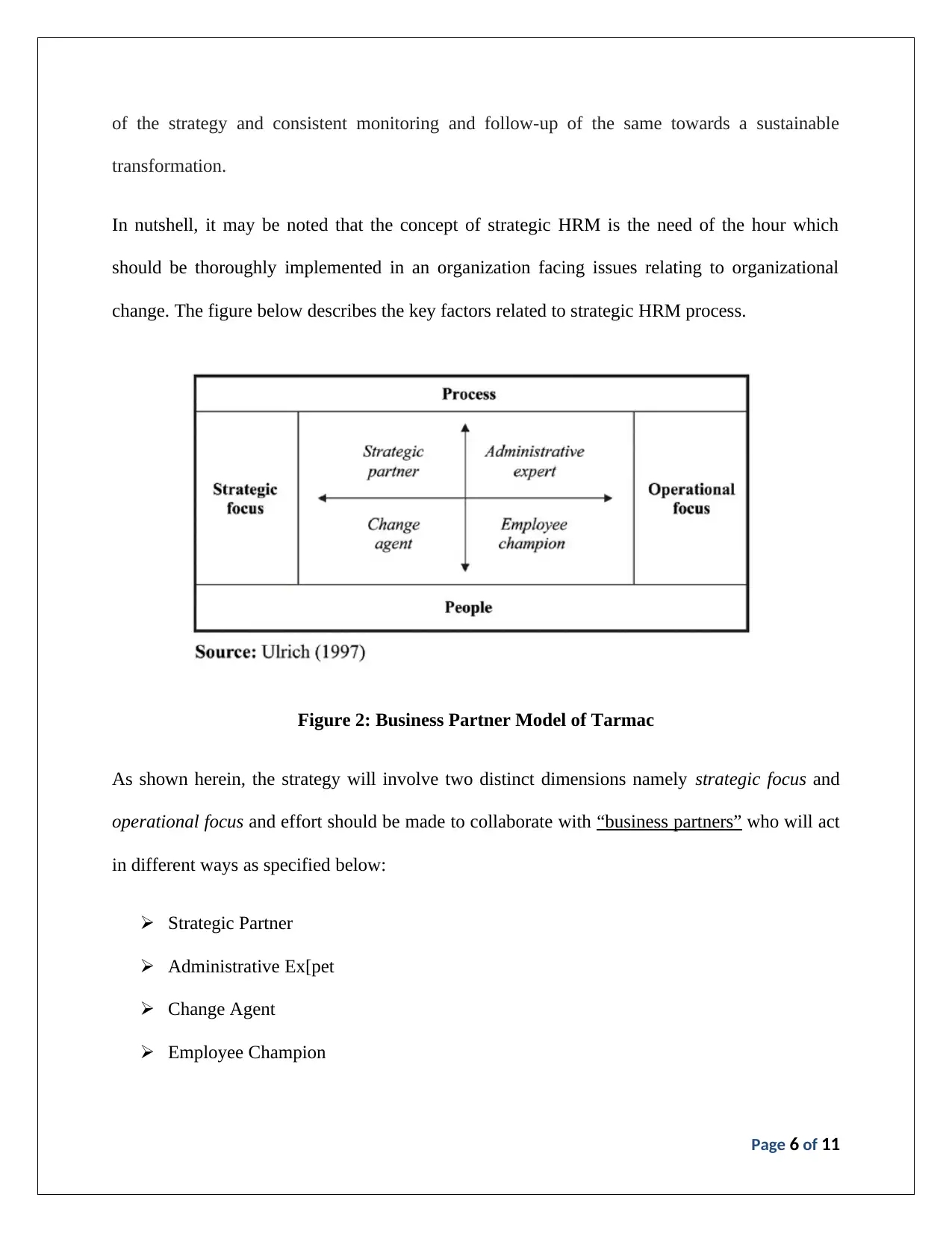
of the strategy and consistent monitoring and follow-up of the same towards a sustainable
transformation.
In nutshell, it may be noted that the concept of strategic HRM is the need of the hour which
should be thoroughly implemented in an organization facing issues relating to organizational
change. The figure below describes the key factors related to strategic HRM process.
Figure 2: Business Partner Model of Tarmac
As shown herein, the strategy will involve two distinct dimensions namely strategic focus and
operational focus and effort should be made to collaborate with “business partners” who will act
in different ways as specified below:
Strategic Partner
Administrative Ex[pet
Change Agent
Employee Champion
Page 6 of 11
transformation.
In nutshell, it may be noted that the concept of strategic HRM is the need of the hour which
should be thoroughly implemented in an organization facing issues relating to organizational
change. The figure below describes the key factors related to strategic HRM process.
Figure 2: Business Partner Model of Tarmac
As shown herein, the strategy will involve two distinct dimensions namely strategic focus and
operational focus and effort should be made to collaborate with “business partners” who will act
in different ways as specified below:
Strategic Partner
Administrative Ex[pet
Change Agent
Employee Champion
Page 6 of 11
⊘ This is a preview!⊘
Do you want full access?
Subscribe today to unlock all pages.

Trusted by 1+ million students worldwide
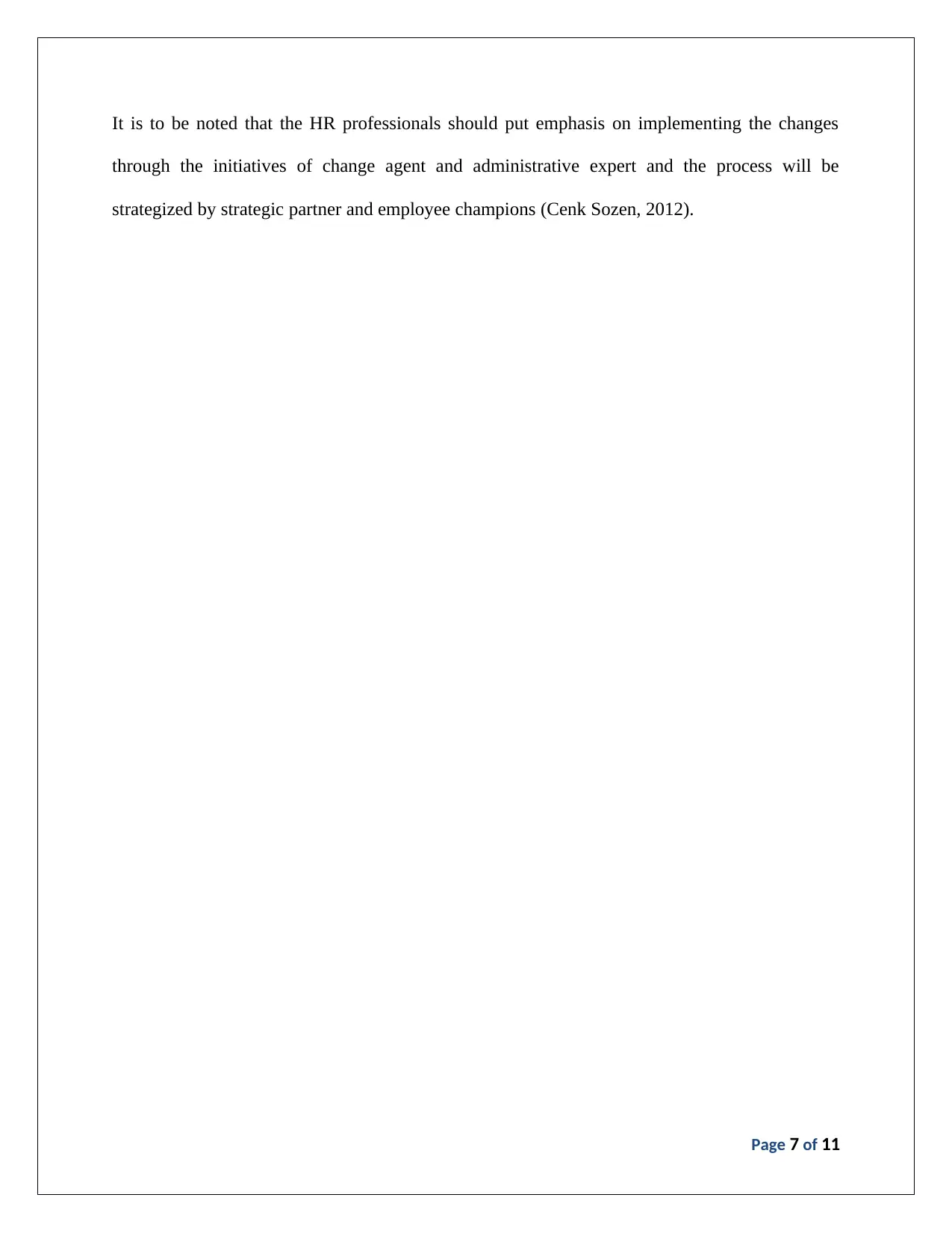
It is to be noted that the HR professionals should put emphasis on implementing the changes
through the initiatives of change agent and administrative expert and the process will be
strategized by strategic partner and employee champions (Cenk Sozen, 2012).
Page 7 of 11
through the initiatives of change agent and administrative expert and the process will be
strategized by strategic partner and employee champions (Cenk Sozen, 2012).
Page 7 of 11
Paraphrase This Document
Need a fresh take? Get an instant paraphrase of this document with our AI Paraphraser
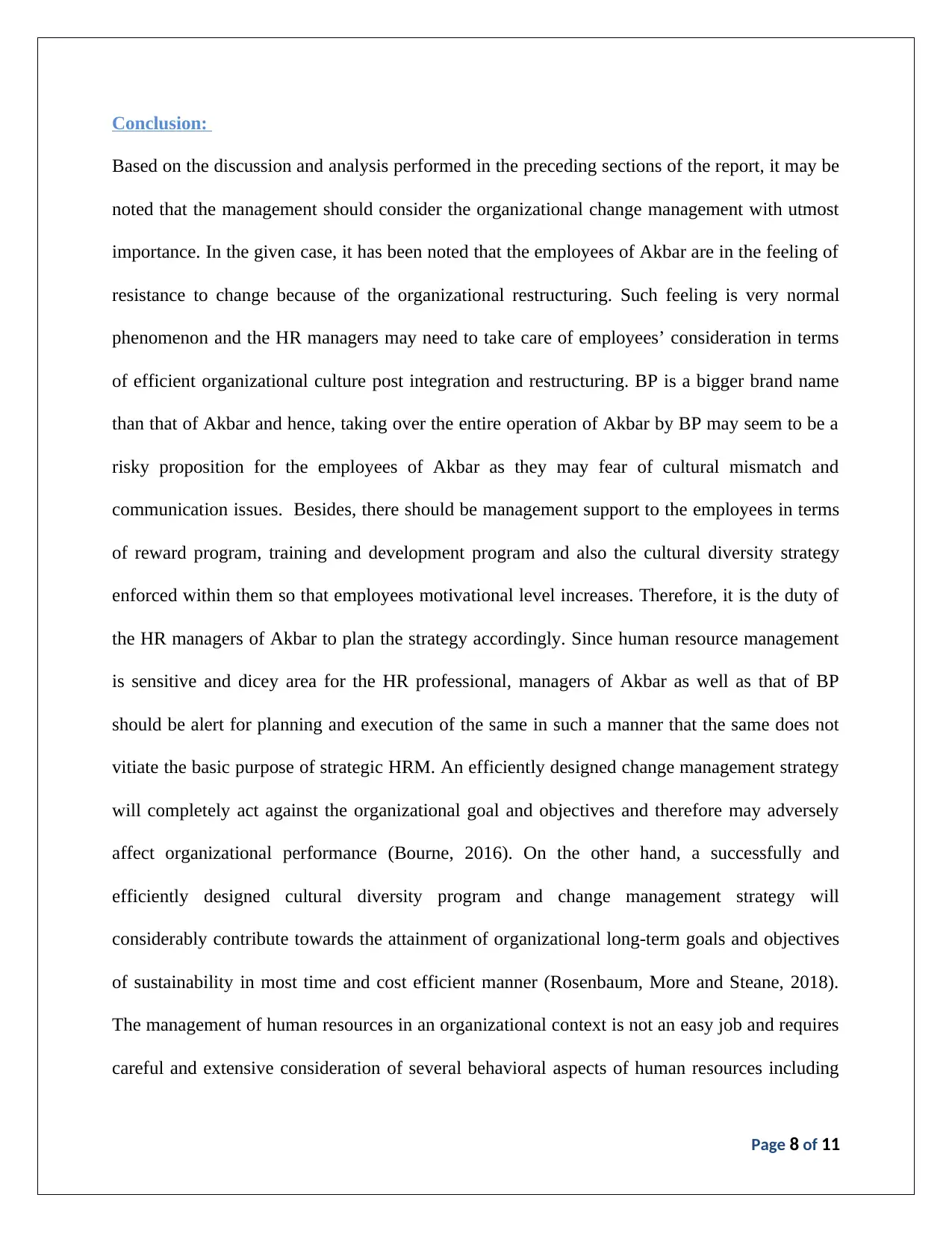
Conclusion:
Based on the discussion and analysis performed in the preceding sections of the report, it may be
noted that the management should consider the organizational change management with utmost
importance. In the given case, it has been noted that the employees of Akbar are in the feeling of
resistance to change because of the organizational restructuring. Such feeling is very normal
phenomenon and the HR managers may need to take care of employees’ consideration in terms
of efficient organizational culture post integration and restructuring. BP is a bigger brand name
than that of Akbar and hence, taking over the entire operation of Akbar by BP may seem to be a
risky proposition for the employees of Akbar as they may fear of cultural mismatch and
communication issues. Besides, there should be management support to the employees in terms
of reward program, training and development program and also the cultural diversity strategy
enforced within them so that employees motivational level increases. Therefore, it is the duty of
the HR managers of Akbar to plan the strategy accordingly. Since human resource management
is sensitive and dicey area for the HR professional, managers of Akbar as well as that of BP
should be alert for planning and execution of the same in such a manner that the same does not
vitiate the basic purpose of strategic HRM. An efficiently designed change management strategy
will completely act against the organizational goal and objectives and therefore may adversely
affect organizational performance (Bourne, 2016). On the other hand, a successfully and
efficiently designed cultural diversity program and change management strategy will
considerably contribute towards the attainment of organizational long-term goals and objectives
of sustainability in most time and cost efficient manner (Rosenbaum, More and Steane, 2018).
The management of human resources in an organizational context is not an easy job and requires
careful and extensive consideration of several behavioral aspects of human resources including
Page 8 of 11
Based on the discussion and analysis performed in the preceding sections of the report, it may be
noted that the management should consider the organizational change management with utmost
importance. In the given case, it has been noted that the employees of Akbar are in the feeling of
resistance to change because of the organizational restructuring. Such feeling is very normal
phenomenon and the HR managers may need to take care of employees’ consideration in terms
of efficient organizational culture post integration and restructuring. BP is a bigger brand name
than that of Akbar and hence, taking over the entire operation of Akbar by BP may seem to be a
risky proposition for the employees of Akbar as they may fear of cultural mismatch and
communication issues. Besides, there should be management support to the employees in terms
of reward program, training and development program and also the cultural diversity strategy
enforced within them so that employees motivational level increases. Therefore, it is the duty of
the HR managers of Akbar to plan the strategy accordingly. Since human resource management
is sensitive and dicey area for the HR professional, managers of Akbar as well as that of BP
should be alert for planning and execution of the same in such a manner that the same does not
vitiate the basic purpose of strategic HRM. An efficiently designed change management strategy
will completely act against the organizational goal and objectives and therefore may adversely
affect organizational performance (Bourne, 2016). On the other hand, a successfully and
efficiently designed cultural diversity program and change management strategy will
considerably contribute towards the attainment of organizational long-term goals and objectives
of sustainability in most time and cost efficient manner (Rosenbaum, More and Steane, 2018).
The management of human resources in an organizational context is not an easy job and requires
careful and extensive consideration of several behavioral aspects of human resources including
Page 8 of 11
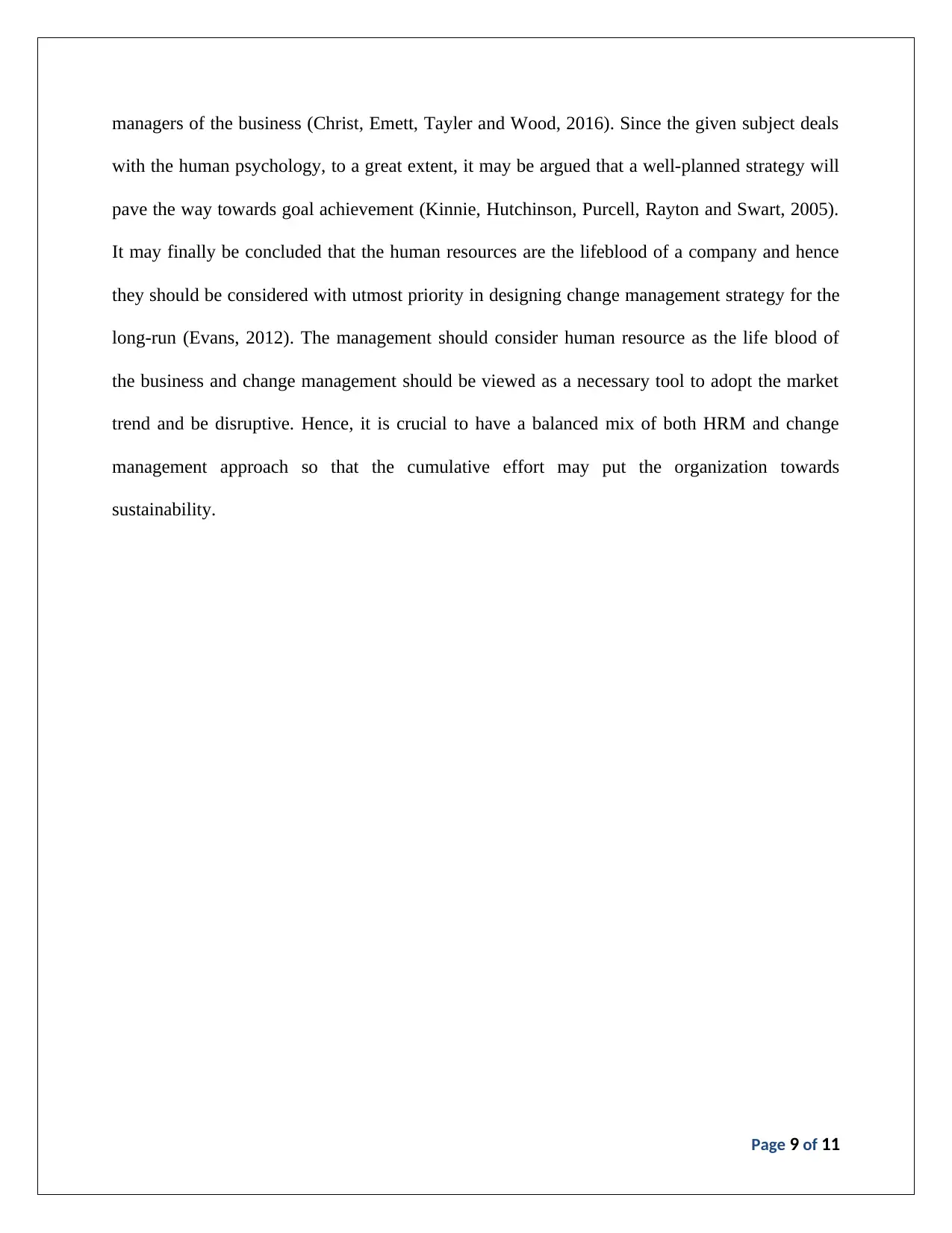
managers of the business (Christ, Emett, Tayler and Wood, 2016). Since the given subject deals
with the human psychology, to a great extent, it may be argued that a well-planned strategy will
pave the way towards goal achievement (Kinnie, Hutchinson, Purcell, Rayton and Swart, 2005).
It may finally be concluded that the human resources are the lifeblood of a company and hence
they should be considered with utmost priority in designing change management strategy for the
long-run (Evans, 2012). The management should consider human resource as the life blood of
the business and change management should be viewed as a necessary tool to adopt the market
trend and be disruptive. Hence, it is crucial to have a balanced mix of both HRM and change
management approach so that the cumulative effort may put the organization towards
sustainability.
Page 9 of 11
with the human psychology, to a great extent, it may be argued that a well-planned strategy will
pave the way towards goal achievement (Kinnie, Hutchinson, Purcell, Rayton and Swart, 2005).
It may finally be concluded that the human resources are the lifeblood of a company and hence
they should be considered with utmost priority in designing change management strategy for the
long-run (Evans, 2012). The management should consider human resource as the life blood of
the business and change management should be viewed as a necessary tool to adopt the market
trend and be disruptive. Hence, it is crucial to have a balanced mix of both HRM and change
management approach so that the cumulative effort may put the organization towards
sustainability.
Page 9 of 11
⊘ This is a preview!⊘
Do you want full access?
Subscribe today to unlock all pages.

Trusted by 1+ million students worldwide
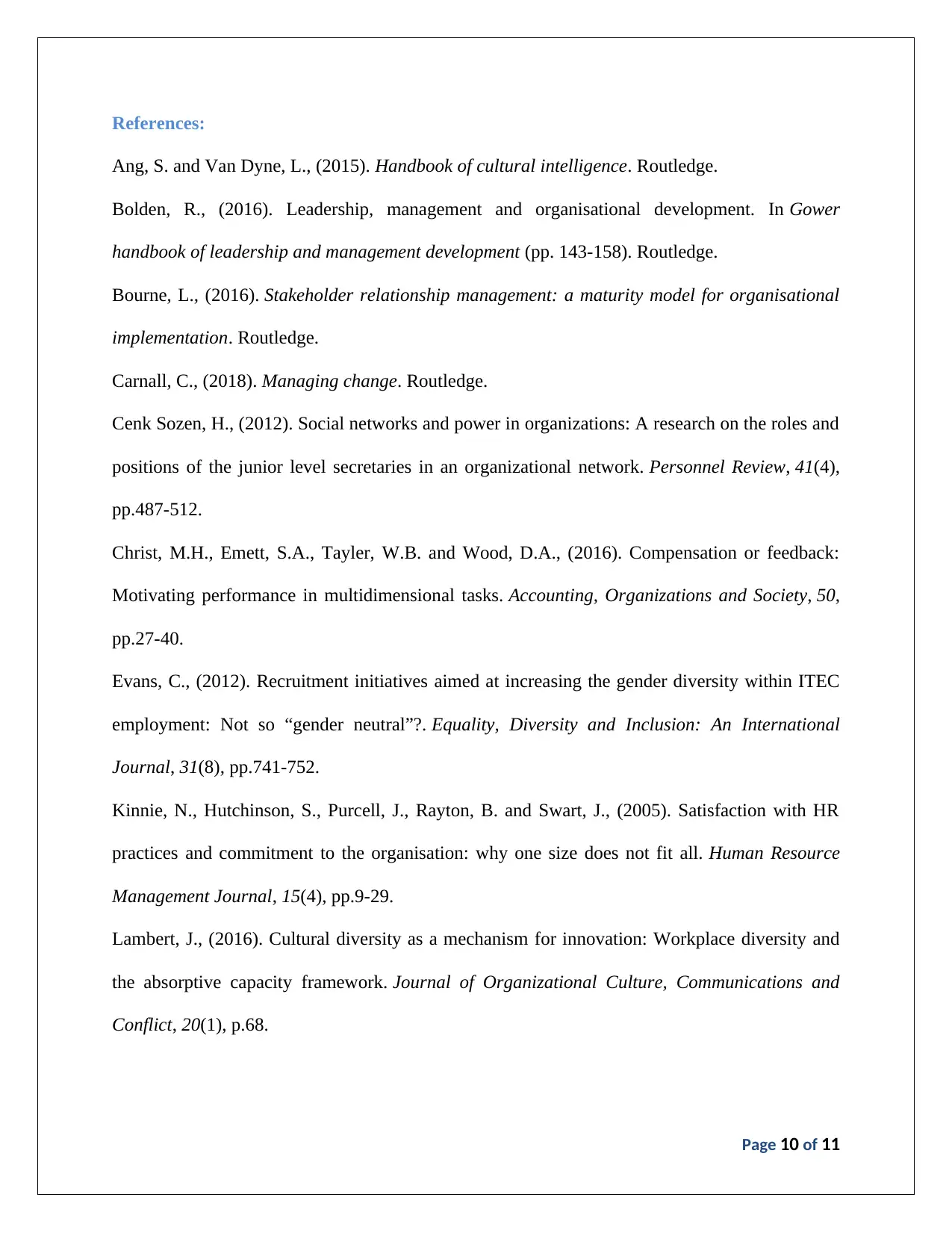
References:
Ang, S. and Van Dyne, L., (2015). Handbook of cultural intelligence. Routledge.
Bolden, R., (2016). Leadership, management and organisational development. In Gower
handbook of leadership and management development (pp. 143-158). Routledge.
Bourne, L., (2016). Stakeholder relationship management: a maturity model for organisational
implementation. Routledge.
Carnall, C., (2018). Managing change. Routledge.
Cenk Sozen, H., (2012). Social networks and power in organizations: A research on the roles and
positions of the junior level secretaries in an organizational network. Personnel Review, 41(4),
pp.487-512.
Christ, M.H., Emett, S.A., Tayler, W.B. and Wood, D.A., (2016). Compensation or feedback:
Motivating performance in multidimensional tasks. Accounting, Organizations and Society, 50,
pp.27-40.
Evans, C., (2012). Recruitment initiatives aimed at increasing the gender diversity within ITEC
employment: Not so “gender neutral”?. Equality, Diversity and Inclusion: An International
Journal, 31(8), pp.741-752.
Kinnie, N., Hutchinson, S., Purcell, J., Rayton, B. and Swart, J., (2005). Satisfaction with HR
practices and commitment to the organisation: why one size does not fit all. Human Resource
Management Journal, 15(4), pp.9-29.
Lambert, J., (2016). Cultural diversity as a mechanism for innovation: Workplace diversity and
the absorptive capacity framework. Journal of Organizational Culture, Communications and
Conflict, 20(1), p.68.
Page 10 of 11
Ang, S. and Van Dyne, L., (2015). Handbook of cultural intelligence. Routledge.
Bolden, R., (2016). Leadership, management and organisational development. In Gower
handbook of leadership and management development (pp. 143-158). Routledge.
Bourne, L., (2016). Stakeholder relationship management: a maturity model for organisational
implementation. Routledge.
Carnall, C., (2018). Managing change. Routledge.
Cenk Sozen, H., (2012). Social networks and power in organizations: A research on the roles and
positions of the junior level secretaries in an organizational network. Personnel Review, 41(4),
pp.487-512.
Christ, M.H., Emett, S.A., Tayler, W.B. and Wood, D.A., (2016). Compensation or feedback:
Motivating performance in multidimensional tasks. Accounting, Organizations and Society, 50,
pp.27-40.
Evans, C., (2012). Recruitment initiatives aimed at increasing the gender diversity within ITEC
employment: Not so “gender neutral”?. Equality, Diversity and Inclusion: An International
Journal, 31(8), pp.741-752.
Kinnie, N., Hutchinson, S., Purcell, J., Rayton, B. and Swart, J., (2005). Satisfaction with HR
practices and commitment to the organisation: why one size does not fit all. Human Resource
Management Journal, 15(4), pp.9-29.
Lambert, J., (2016). Cultural diversity as a mechanism for innovation: Workplace diversity and
the absorptive capacity framework. Journal of Organizational Culture, Communications and
Conflict, 20(1), p.68.
Page 10 of 11
Paraphrase This Document
Need a fresh take? Get an instant paraphrase of this document with our AI Paraphraser
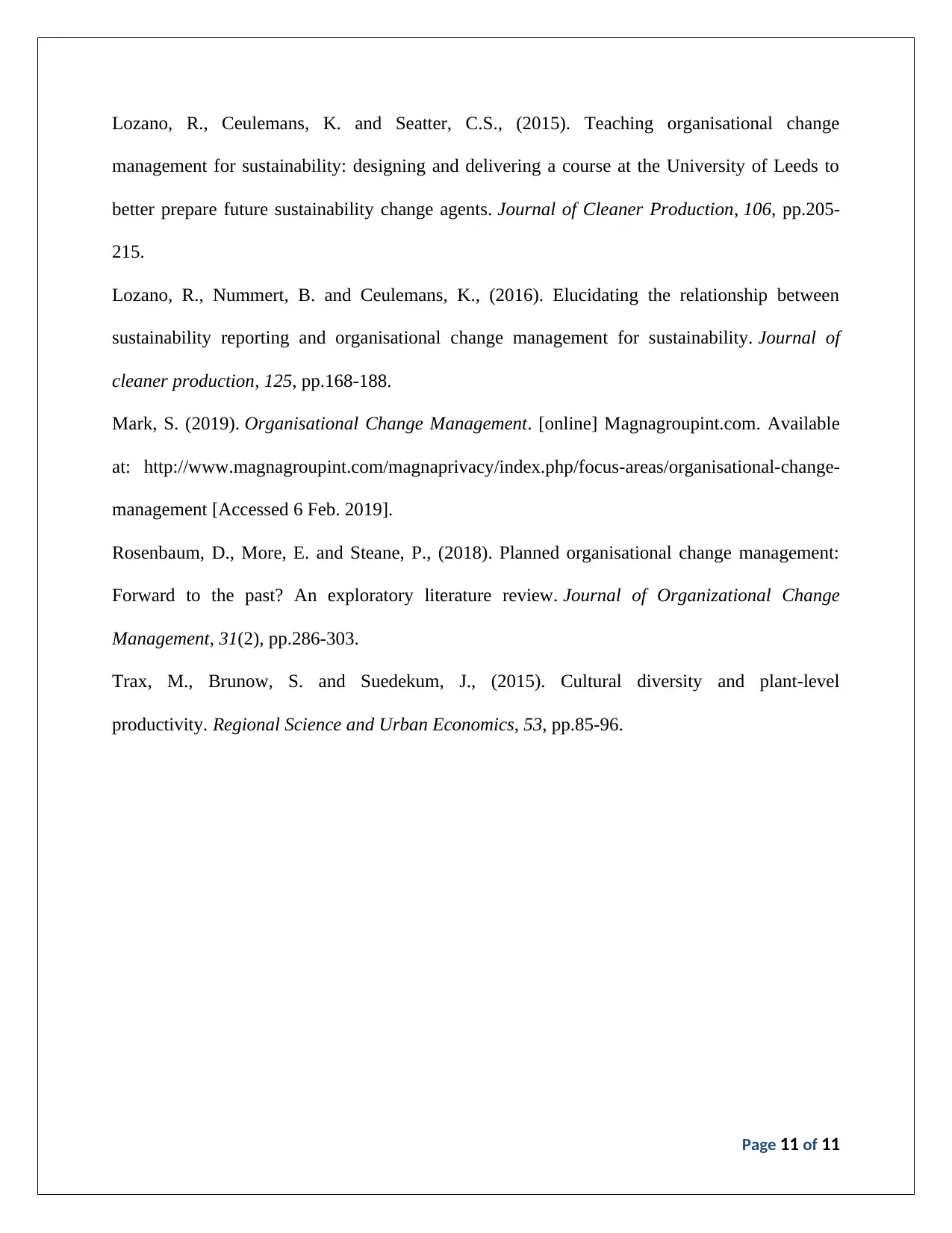
Lozano, R., Ceulemans, K. and Seatter, C.S., (2015). Teaching organisational change
management for sustainability: designing and delivering a course at the University of Leeds to
better prepare future sustainability change agents. Journal of Cleaner Production, 106, pp.205-
215.
Lozano, R., Nummert, B. and Ceulemans, K., (2016). Elucidating the relationship between
sustainability reporting and organisational change management for sustainability. Journal of
cleaner production, 125, pp.168-188.
Mark, S. (2019). Organisational Change Management. [online] Magnagroupint.com. Available
at: http://www.magnagroupint.com/magnaprivacy/index.php/focus-areas/organisational-change-
management [Accessed 6 Feb. 2019].
Rosenbaum, D., More, E. and Steane, P., (2018). Planned organisational change management:
Forward to the past? An exploratory literature review. Journal of Organizational Change
Management, 31(2), pp.286-303.
Trax, M., Brunow, S. and Suedekum, J., (2015). Cultural diversity and plant-level
productivity. Regional Science and Urban Economics, 53, pp.85-96.
Page 11 of 11
management for sustainability: designing and delivering a course at the University of Leeds to
better prepare future sustainability change agents. Journal of Cleaner Production, 106, pp.205-
215.
Lozano, R., Nummert, B. and Ceulemans, K., (2016). Elucidating the relationship between
sustainability reporting and organisational change management for sustainability. Journal of
cleaner production, 125, pp.168-188.
Mark, S. (2019). Organisational Change Management. [online] Magnagroupint.com. Available
at: http://www.magnagroupint.com/magnaprivacy/index.php/focus-areas/organisational-change-
management [Accessed 6 Feb. 2019].
Rosenbaum, D., More, E. and Steane, P., (2018). Planned organisational change management:
Forward to the past? An exploratory literature review. Journal of Organizational Change
Management, 31(2), pp.286-303.
Trax, M., Brunow, S. and Suedekum, J., (2015). Cultural diversity and plant-level
productivity. Regional Science and Urban Economics, 53, pp.85-96.
Page 11 of 11
1 out of 11
Related Documents
Your All-in-One AI-Powered Toolkit for Academic Success.
+13062052269
info@desklib.com
Available 24*7 on WhatsApp / Email
![[object Object]](/_next/static/media/star-bottom.7253800d.svg)
Unlock your academic potential
Copyright © 2020–2025 A2Z Services. All Rights Reserved. Developed and managed by ZUCOL.


